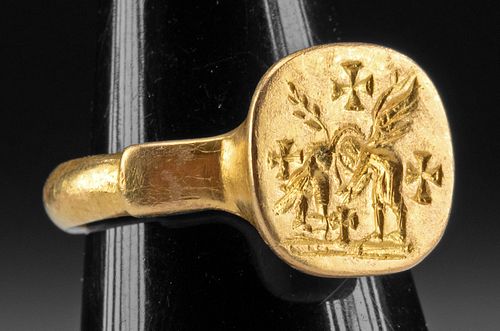5th C. Byzantine Gold Signet Ring, Angel & Dove
Lot 73b
About Seller
Artemis Gallery
686 S Taylor Ave, Ste 106
Louisville, CO 80027
United States
Selling antiquities, ancient and ethnographic art online since 1993, Artemis Gallery specializes in Classical Antiquities (Egyptian, Greek, Roman, Near Eastern), Asian, Pre-Columbian, African / Tribal / Oceanographic art. Our extensive inventory includes pottery, stone, metal, wood, glass and textil...Read more
Categories
Estimate:
$11,000 - $16,500
Absentee vs Live bid
Two ways to bid:
- Leave a max absentee bid and the platform will bid on your behalf up to your maximum bid during the live auction.
- Bid live during the auction and your bids will be submitted real-time to the auctioneer.
Bid Increments
| Price | Bid Increment |
|---|---|
| $0 | $25 |
| $300 | $50 |
| $1,000 | $100 |
| $2,000 | $250 |
| $5,000 | $500 |
| $10,000 | $1,000 |
| $20,000 | $2,500 |
| $50,000 | $5,000 |
| $100,000 | $10,000 |
| $200,000 | $20,000 |
About Auction
By Artemis Gallery
Mar 24, 2022
Set Reminder
2022-03-24 10:00:00
2022-03-24 10:00:00
America/New_York
Bidsquare
Bidsquare : Exceptional Antiquities Ethnographic Fine Art
https://www.bidsquare.com/auctions/artemis-gallery/exceptional-antiquities-ethnographic-fine-art-9057
Museum-worthy examples of classical antiquities (Egyptian, Greek, Roman, Near Eastern), Viking, Far East / Asian, Pre-Columbian, African / Tribal, Oceanic, Native American, Spanish Colonial, Fossils, Ancient Jewelry, Fine / Visual Arts, so much more! Artemis Gallery info@artemisgallery.com
Museum-worthy examples of classical antiquities (Egyptian, Greek, Roman, Near Eastern), Viking, Far East / Asian, Pre-Columbian, African / Tribal, Oceanic, Native American, Spanish Colonial, Fossils, Ancient Jewelry, Fine / Visual Arts, so much more! Artemis Gallery info@artemisgallery.com
- Lot Description
Near East, Byzantine, ca. 5th to 7th century CE. A dazzling gold signet ring presenting a slender band and stepped shoulder leading to a large bezel incised with the image of an angel and a dove. Facing left, the sacred figure bends downward to place a Byzantine cross at the foot of the bird. A sizeable wing rises from the angel's back as a knee-length robe drapes over his body and a halo encircles the head. Alternatively, the avian animal faces right, standing with wings tucked at its side and head bowed, while holding an olive branch in its beak - a common Early Christian symbol of deliverance, intended to represent a scene from the story of Noah's Ark in the Book of Genesis in which a bird returns to the Ark with an olive branch indicating that land was near and thus symbolizing that Noah and his family would be rescued from the flood. Size (ring): 0.9" Diameter (2.3 cm); (bezel): 0.5" L x 0.5" W (1.3 cm x 1.3 cm); gold quality: 89% (equivalent to over 21 karats); weight: 10.1 grams; US ring size: 5.75
A trio of Byzantine crosses surround the pair, forming a triangle reminiscent of the Christian Holy Trinity. Note how the angel's wing and olive branch form perpendicular axes leading the viewers eye to the heads of both figures. A stunning piece of jewelry, replete with artistic virtuosity and early Christian iconography!
Rings were of particularly high importance in the Byzantine era. Gary Vikan in "Early Christian and Byzantine Rings in the Zucker Family Collection" notes, "No article of personal adornment was more prevalent in Byzantine society nor more important to the conduct of an individual's private and public business than was a signet ring. The emperor wore an official ring as a symbol of power and as an implement for the authentication of certain communications and documents, and the same was true for a wide range of civil and ecclesiastical officials. As for the average citizen, signets in their locking capacity were essential for the maintenance of personal security, whereas signets in their authenticating capacity were required by law for the validation of wills and testaments. Beyond this, rings functioned in a purely social context as jewelry - as a natural and traditional mode of self adornment." (The Journal of the Walters Art Gallery 45, 1987: page 32)
In the fourth century, Christian imagery as a subject for insignia rings rose in popularity as a response to Constantine's legitimation and growing dominance of the faith, especially in the western Roman Empire. Thus, Christian symbols of deliverance became increasingly fashionable motifs to sport on one's fingers and often morphed from previously neutral images, just as the formerly conventional motif of a bird changed into the bird and olive branch of the Old Testament that we see here.
Provenance: private Boynton Beach, Florida, USA collection; ex-private Atlanta, Georgia, USA collection, acquired in 2013; ex-Artemission Gallery, London, United Kingdom
All items legal to buy/sell under U.S. Statute covering cultural patrimony Code 2600, CHAPTER 14, and are guaranteed to be as described or your money back.
A Certificate of Authenticity will accompany all winning bids.
PLEASE NOTE: Due to recent increases of shipments being seized by Australian & German customs (even for items with pre-UNESCO provenance), we will no longer ship most antiquities and ancient Chinese art to Australia & Germany. For categories of items that are acceptable to ship to Australia or Germany, please contact us directly or work with your local customs brokerage firm.
Display stands not described as included/custom in the item description are for photography purposes only and will not be included with the item upon shipping.
#170765Some light scratches and nicks to band, shoulder, and verso of bezel. Minor abrasions to field of incised design. Otherwise, intact, excellent, and wearable with impressively preserved detail.Condition
- Shipping Info
-
All shipping is handled in-house for your convenience. Your invoice from Artemis Gallery will include shipping calculation instructions. If in doubt, please inquire BEFORE bidding for estimated shipping costs for individual items.
-
- Buyer's Premium



 EUR
EUR CAD
CAD AUD
AUD GBP
GBP MXN
MXN HKD
HKD CNY
CNY MYR
MYR SEK
SEK SGD
SGD CHF
CHF THB
THB













